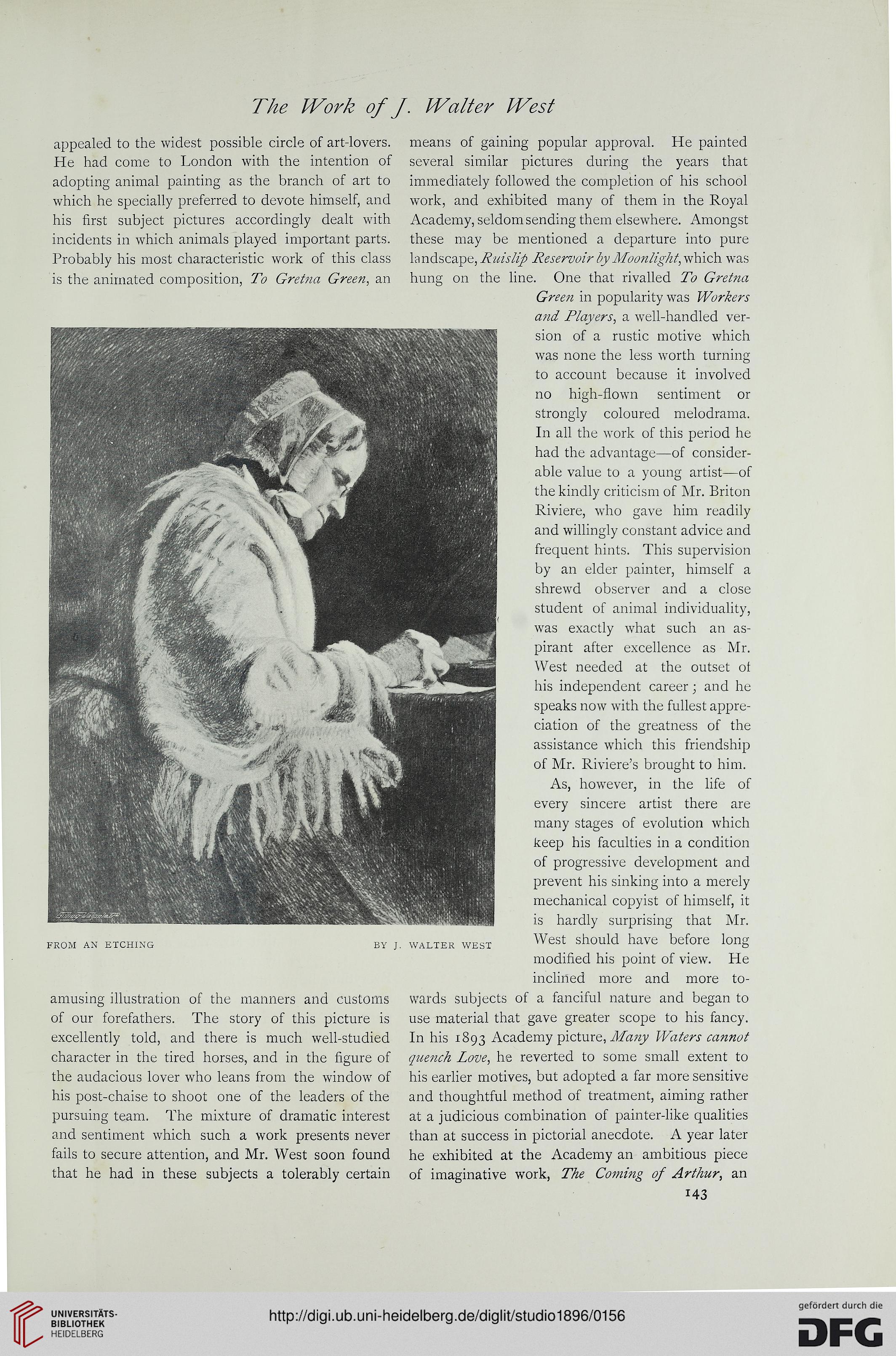The Work of J. Walter West
appealed to the widest possible circle of art-lovers, means of gaining popular approval. He painted
He had come to London with the intention of several similar pictures during the years that
adopting animal painting as the branch of art to immediately followed the completion of his school
which he specially preferred to devote himself, and work, and exhibited many of them in the Royal
his first subject pictures accordingly dealt with Academy, seldom sending them elsewhere. Amongst
incidents in which animals played important parts, these may be mentioned a departure into pure
Probably his most characteristic work of this class landscape, Ruts lip Reservoir by Moonlight, which was
is the animated composition, To Gretna Green, an hung on the line. One that rivalled To Gretna
Green in popularity was Workers
and Players, a well-handled ver-
sion of a rustic motive which
was none the less worth turning
to account because it involved
no high-flown sentiment or
strongly coloured melodrama.
In all the work of this period he
had the advantage—of consider-
able value to a young artist—of
the kindly criticism of Mr. Briton
Riviere, who gave him readily
and willingly constant advice and
frequent hints. This supervision
by an elder painter, himself a
shrewd observer and a close
student of animal individuality,
was exactly what such an as-
pirant after excellence as Mr.
West needed at the outset of
his independent career; and he
speaks now with the fullest appre-
ciation of the greatness of the
assistance which this friendship
of Mr. Riviere's brought to him.
As, however, in the life of
every sincere artist there are
many stages of evolution which
keep his faculties in a condition
of progressive development and
prevent his sinking into a merely
mechanical copyist of himself, it
is hardly surprising that Mr.
from an etching by j. Walter west West should have before long
modified his point of view. He
inclined more and more to-
amusing illustration of the manners and customs wards subjects of a fanciful nature and began to
of our forefathers. The story of this picture is use material that gave greater scope to his fancy,
excellently told, and there is much well-studied In his 1893 Academy picture, Many Waters cannot
character in the tired horses, and in the figure of quench Love, he reverted to some small extent to
the audacious lover who leans from the window of his earlier motives, but adopted a far more sensitive
his post-chaise to shoot one of the leaders of the and thoughtful method of treatment, aiming rather
pursuing team. The mixture of dramatic interest at a judicious combination of painter-like qualities
and sentiment which such a work presents never than at success in pictorial anecdote. A year later
fails to secure attention, and Mr. West soon found he exhibited at the Academy an ambitious piece
that he had in these subjects a tolerably certain of imaginative work, The Coming of Arthur, an
143
appealed to the widest possible circle of art-lovers, means of gaining popular approval. He painted
He had come to London with the intention of several similar pictures during the years that
adopting animal painting as the branch of art to immediately followed the completion of his school
which he specially preferred to devote himself, and work, and exhibited many of them in the Royal
his first subject pictures accordingly dealt with Academy, seldom sending them elsewhere. Amongst
incidents in which animals played important parts, these may be mentioned a departure into pure
Probably his most characteristic work of this class landscape, Ruts lip Reservoir by Moonlight, which was
is the animated composition, To Gretna Green, an hung on the line. One that rivalled To Gretna
Green in popularity was Workers
and Players, a well-handled ver-
sion of a rustic motive which
was none the less worth turning
to account because it involved
no high-flown sentiment or
strongly coloured melodrama.
In all the work of this period he
had the advantage—of consider-
able value to a young artist—of
the kindly criticism of Mr. Briton
Riviere, who gave him readily
and willingly constant advice and
frequent hints. This supervision
by an elder painter, himself a
shrewd observer and a close
student of animal individuality,
was exactly what such an as-
pirant after excellence as Mr.
West needed at the outset of
his independent career; and he
speaks now with the fullest appre-
ciation of the greatness of the
assistance which this friendship
of Mr. Riviere's brought to him.
As, however, in the life of
every sincere artist there are
many stages of evolution which
keep his faculties in a condition
of progressive development and
prevent his sinking into a merely
mechanical copyist of himself, it
is hardly surprising that Mr.
from an etching by j. Walter west West should have before long
modified his point of view. He
inclined more and more to-
amusing illustration of the manners and customs wards subjects of a fanciful nature and began to
of our forefathers. The story of this picture is use material that gave greater scope to his fancy,
excellently told, and there is much well-studied In his 1893 Academy picture, Many Waters cannot
character in the tired horses, and in the figure of quench Love, he reverted to some small extent to
the audacious lover who leans from the window of his earlier motives, but adopted a far more sensitive
his post-chaise to shoot one of the leaders of the and thoughtful method of treatment, aiming rather
pursuing team. The mixture of dramatic interest at a judicious combination of painter-like qualities
and sentiment which such a work presents never than at success in pictorial anecdote. A year later
fails to secure attention, and Mr. West soon found he exhibited at the Academy an ambitious piece
that he had in these subjects a tolerably certain of imaginative work, The Coming of Arthur, an
143




